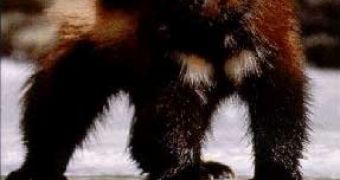Wolverine is the largest land-dwelling relative of the weasel (overall, the largest would be the giant otter of South America). The wolverine is considered, relative to its size, the most powerful carnivorous mammal. Even if a wolverine is no larger than 25 kg (55 pounds), it can kill reindeer and moose!
This meat eater is a dweller of the subarctic coniferous forests of North America and Eurasia. A wolverine resembles somehow a bear, with the large head, small ears, voluminous body covered by a soft and dense coat, short tail (but not as short as the bears'), and short, massive limbs endowed with powerful claws.
Wolverines are also called gluttons because they can ingest huge amounts of food, especially during the wintertime.
Male wolverines have territories up to 1,000 square km (400 square mi), while a female has a territory up to 350 square km (140 square mi). The territory is marked through urine, feces and secretions of the abdominal and ventral glands.
The wolverine use for shelter a den, a small cave, a crack between rocks or a fallen tree, making itself a bed of leaves and grass. The animal is mainly nocturnal, but sometimes it can be active during the daytime. It can make 45 km (30 mi) per night in the search for food and can maintain a swift gallop for over 10 km (6 mi). This animal can climb rapidly in the trees.
Wolverines hunt during the summer rodents, rabbits, birds, frogs, insects and during the winter it attacks even larger preys, even if it usually consume them as carrion or leftovers of wolf kills or trapped animals. These meat eaters are so powerful that they can chase away from carrions wolves, pumas and even bears! In some areas, they kill sheep and lambs, but they can attack and kill easily reindeer and moose when the snow is deep, impeding the animals to move quickly. The wolverines jump on the deer's back and apply their extremely powerful bite to the neck, till the exhausted prey falls. This performance, related to the wolverine's and reindeer's or moose's sizes, is like a lion killing by itself a rhinoceros.
Gluttons will not discard eggs found on the ground and even some fruits in the autumn. Sometimes, wolverines hang on the branches of the trees, at heights of 5-8 m (16-27 ft), remains of their prey, as food reserves.
Breeding season takes place from April to September (this way the solitary animals have a chance to find a partner) but the embryo's development is delayed, so that births occur from January to April, the gestation lasting only 30-40 days. The female gives birth to 2-4 blind, helpless offspring in a nest dug under the snow. They are milk fed for two months and get independent from the mother late in the autumn. The adult size is reached by the age of one year, when they distance 30-100 km (20-60 mi) from the mother's territory.

 14 DAY TRIAL //
14 DAY TRIAL //